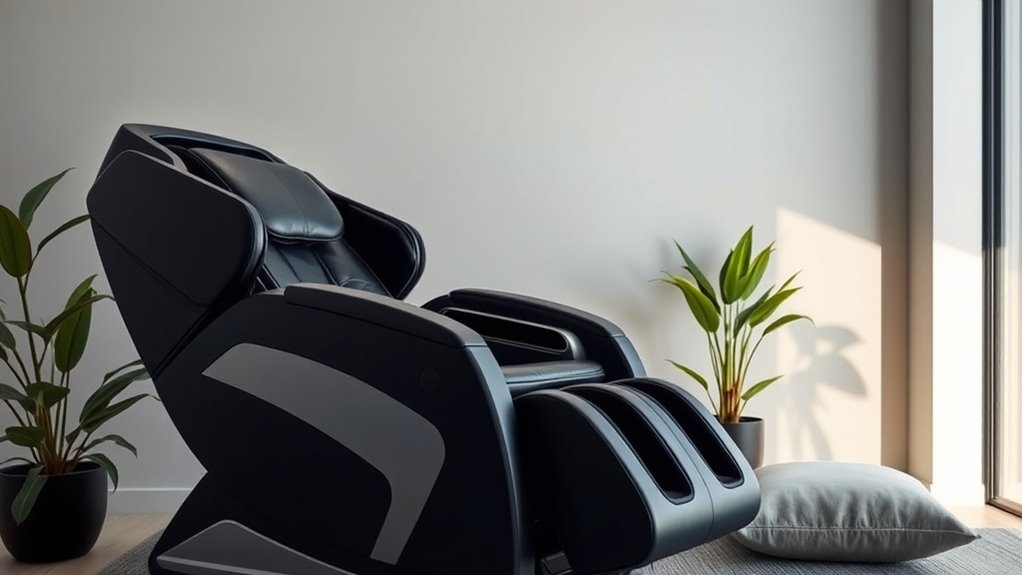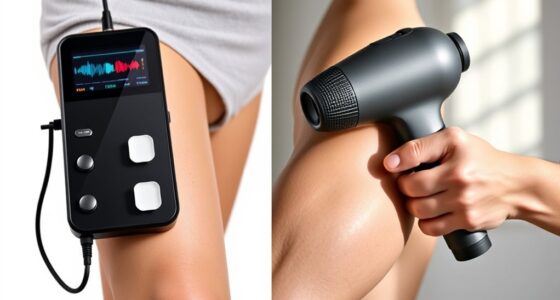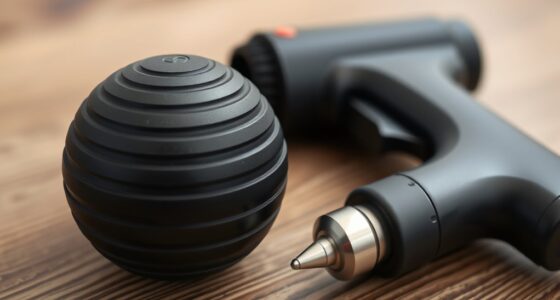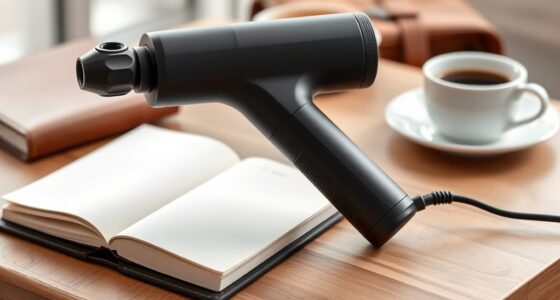Quiet motors in recovery devices help create a peaceful environment by reducing noise and vibrations. This means fewer distractions, less stress, and more comfort during your sessions. Because of the smooth operation, you’ll experience less fatigue and enjoy a more relaxed routine. Additionally, the noise reduction benefits extend to shared spaces or home use, making your recovery more discreet and soothing. Keep exploring to discover how these innovations can transform your recovery experience even further.
Key Takeaways
- Quiet motors reduce noise pollution, creating a calm environment that enhances focus and relaxation during recovery sessions.
- They minimize physical discomfort caused by loud vibrations, making prolonged use more comfortable.
- Advanced noise mitigation ensures consistent, unobtrusive operation, supporting a peaceful therapy or workout setting.
- Reduced noise levels help prevent disturbance to others, enabling discreet and shared recovery environments.
- Overall, noise-reduction technology improves user experience by fostering comfort, motivation, and adherence to recovery routines.
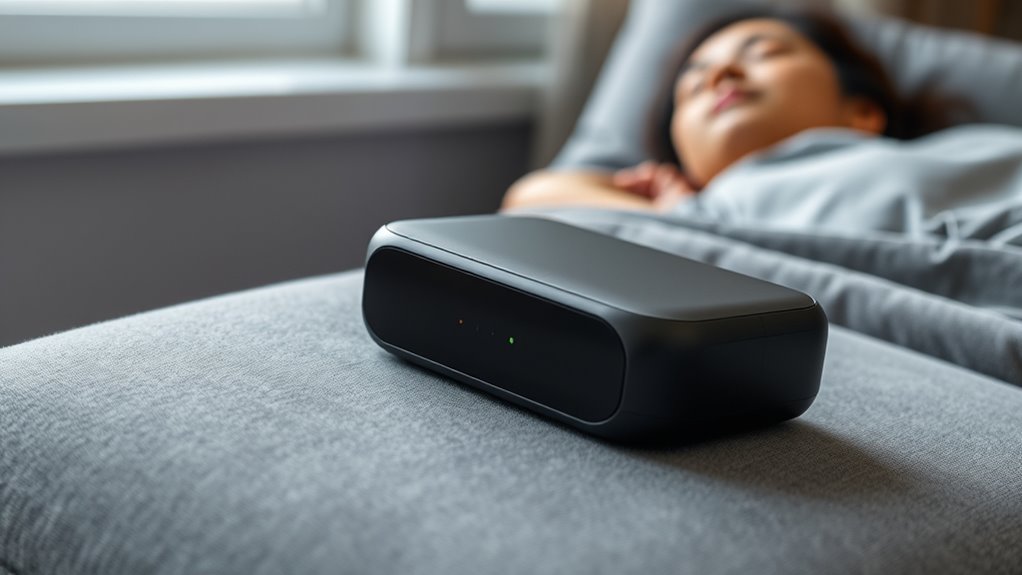
Noise-reduction technology has become essential in our increasingly noisy world, helping you experience clearer sound and a quieter environment. When you’re focused on recovery sessions, whether at a gym, therapy center, or home, minimizing distractions like loud motor sounds can make a noteworthy difference. Many modern equipment now features quiet motors that operate smoothly and quietly, allowing you to concentrate solely on your recovery without unnecessary interruptions. These quieter motors don’t just improve the auditory experience; they also enhance your overall comfort during use.
Quiet motors enhance recovery by reducing noise and increasing comfort during sessions.
You’ll notice that with reduced motor noise, your recovery environment feels calmer and more peaceful. This is especially important if you prefer quiet settings or are sensitive to noise. The less intrusive the motor sound, the more you can focus on your breathing, movements, and the progress you’re making. Quiet motors also mean less vibration and less noise pollution in your surroundings, creating a more relaxing experience. When the motor operates quietly, it minimizes the risk of disturbing others around you, making it easier to use your recovery equipment in shared spaces or at home without feeling self-conscious.
User comfort is a top priority when integrating noise-reduction technology into recovery devices. A quiet motor reduces not just noise but also the physical strain caused by constant loud vibrations. The smoother operation of these motors often translates to less harsh jolts, creating a more comfortable experience, especially during longer sessions. You won’t have to deal with the fatigue or annoyance that comes with loud, vibrating machines, which can sometimes cause discomfort or even stress. Instead, you get a seamless, gentle experience that encourages you to stick with your recovery routine.
Additionally, noise mitigation techniques in motor design ensure that even during extended use, the equipment remains unobtrusive and pleasant to operate. Furthermore, quiet motors often feature advanced engineering that ensures consistent, reliable performance. This means you don’t have to worry about sudden increases in noise or vibrations disrupting your session. Instead, you experience a steady, controlled operation that aligns with your need for a focused, comfortable environment. As a result, you’ll find it easier to stay motivated and engaged, knowing that your equipment supports your recovery without adding unnecessary noise or discomfort. Overall, the integration of noise-reduction technology in motors not only benefits your auditory environment but also considerably enhances your user comfort, making each recovery session more effective and enjoyable.
Frequently Asked Questions
How Do Quiet Motors Impact Overall Device Durability?
Quiet motors enhance your device’s durability by reducing stress on internal components, leading to a longer motor lifespan. With less vibration, there’s decreased wear and tear, which prevents early breakdowns. You’ll notice your device operates more smoothly over time, saving you money on repairs or replacements. Overall, quieter motors contribute to a more reliable, long-lasting device, ensuring you get consistent performance during every recovery session.
Are Noise-Reduction Features Effective During Long-Term Use?
Like a vintage silent movie, noise-reduction features are surprisingly effective over the long haul. You’ll notice sound insulation and vibration damping keep the device quieter during extended use, reducing fatigue and discomfort. These features help maintain consistent performance, so your recovery sessions stay peaceful and effective. Trust that quiet motors are designed to endure, providing reliable operation without the disruptive noise that can wear down lesser systems over time.
Do Quieter Motors Require Additional Maintenance or Upgrades?
Quieter motors generally don’t need extra maintenance or upgrades if you keep up with regular motor lubrication. Proper lubrication reduces component wear, helping the motor stay quiet and efficient longer. However, it’s good to examine for any unusual noises or vibrations over time, which could indicate the need for maintenance. Staying proactive ensures your quiet motor continues to operate smoothly during your recovery sessions without extra effort or costs.
Can Noise-Reduction Technology Improve User Comfort Beyond Noise Levels?
Absolutely, noise-reduction technology can enhance your overall sensory experience, making your recovery sessions more enjoyable. By reducing disruptive sounds, it creates a soothing environment that minimizes stress and helps you relax fully. This improved user comfort means you can focus better on your recovery, feel more at ease, and truly benefit from each session. Quiet motors don’t just lower noise—they elevate your entire wellness experience.
How Does Noise Reduction Influence Energy Efficiency?
Noise reduction enhances energy efficiency by improving sound insulation, which minimizes the need for additional soundproofing or louder operation. When motors operate quietly, they often use less energy because they experience less strain and friction. This promotes energy conservation, helping your recovery sessions be more eco-friendly and cost-effective. You’ll notice a smoother, quieter experience that doesn’t compromise power, maximizing both comfort and efficiency during your sessions.
Conclusion
Imagine a world where your recovery sessions are as peaceful as a whispering breeze—thanks to noise-reduction technology. Quiet motors don’t just hum silently; they transform your experience, turning distractions into harmony. Isn’t it time you embraced the serenity that comes with these innovations? With every gentle hum, you get closer to true relaxation. Don’t let noise drown out your progress—let quiet motors be the symphony of your recovery journey.
